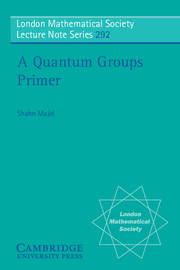Book contents
- Frontmatter
- Contents
- Preface
- 1 Coalgebras, bialgebras and Hopf algebras. Uq(b+)
- 2 Dual pairing. SLq(2). Actions
- 3 Coactions. Quantum plane A2q
- 4 Automorphism quantum groups
- 5 Quasitriangular structures
- 6 Roots of unity. uq(sl2)
- 7 q-Binomials
- 8 Quantum double. Dual-quasitriangular structures
- 9 Braided categories
- 10 (Co)module categories. Crossed modules
- 11 q-Hecke algebras
- 12 Rigid objects. Dual representations. Quantum dimension
- 13 Knot invariants
- 14 Hopf algebras in braided categories. Coaddition on A2q
- 15 Braided differentiation
- 16 Bosonisation. Inhomogeneous quantum groups
- 17 Double bosonisation. Diagrammatic construction of uq(sl2)
- 18 The braided group uq(n+). Construction of uq(g)
- 19 q-Serre relations
- 20 R-matrix methods
- 21 Group, algebra, Hopf algebra factorisations. Bicrossproducts
- 22 Lie bialgebras. Lie splittings. Iwasawa decomposition
- 23 Poisson geometry. Noncommutative bundles. q-Sphere
- 24 Connections. q-Monopole. Nonuniversal differentials
- Problems
- Bibliography
- Index
16 - Bosonisation. Inhomogeneous quantum groups
Published online by Cambridge University Press: 18 January 2010
- Frontmatter
- Contents
- Preface
- 1 Coalgebras, bialgebras and Hopf algebras. Uq(b+)
- 2 Dual pairing. SLq(2). Actions
- 3 Coactions. Quantum plane A2q
- 4 Automorphism quantum groups
- 5 Quasitriangular structures
- 6 Roots of unity. uq(sl2)
- 7 q-Binomials
- 8 Quantum double. Dual-quasitriangular structures
- 9 Braided categories
- 10 (Co)module categories. Crossed modules
- 11 q-Hecke algebras
- 12 Rigid objects. Dual representations. Quantum dimension
- 13 Knot invariants
- 14 Hopf algebras in braided categories. Coaddition on A2q
- 15 Braided differentiation
- 16 Bosonisation. Inhomogeneous quantum groups
- 17 Double bosonisation. Diagrammatic construction of uq(sl2)
- 18 The braided group uq(n+). Construction of uq(g)
- 19 q-Serre relations
- 20 R-matrix methods
- 21 Group, algebra, Hopf algebra factorisations. Bicrossproducts
- 22 Lie bialgebras. Lie splittings. Iwasawa decomposition
- 23 Poisson geometry. Noncommutative bundles. q-Sphere
- 24 Connections. q-Monopole. Nonuniversal differentials
- Problems
- Bibliography
- Index
Summary
We have completed our introduction to ‘braided geometry’ with the basic constructions and basic examples. We are now ready to apply these methods back to ordinary Hopf algebras. The construction in this lecture is called ‘bosonisation’ because it turns a braided group (which is a generalisation of a supergroup) into an ordinary Hopf algebra (such as an ordinary group) [the term comes from physics].
First of all, a general concept which we will use. It is just for clarity (we are not going to do any heavy category theory). Thus, a monoidal functor F : C → V between monoidal categories is a pair (F : c) where
1. F is a functor.
2. c: F2 → F ∘ × is a natural isomorphism between the functors F2, F ∘ × : C×C → V (here F2(V, W) = F(V) × F(W)). This is a collection of functorial isomorphisms
3. The condition in Figure 16.1 holds.
4. We also require
for compatibility with the unit object.
This is more or less obvious, and in fact in our present applications, Φ will be the trivial vector space associativity and c will also be the trivial vector space identification. So we are just saying that F respects ×.
Lemma 16.1
Let H be a quasitriangular Hopf algebra. There is a monoidal functor
for all v ∈ V. Here (β is said to be the coaction ‘induced’ by an action on any module V.
Proof This is a nice exercise from the axioms of a quasitriangular structure. That (β is indeed a coaction is the (id × δ)R axiom.
- Type
- Chapter
- Information
- A Quantum Groups Primer , pp. 98 - 104Publisher: Cambridge University PressPrint publication year: 2002



